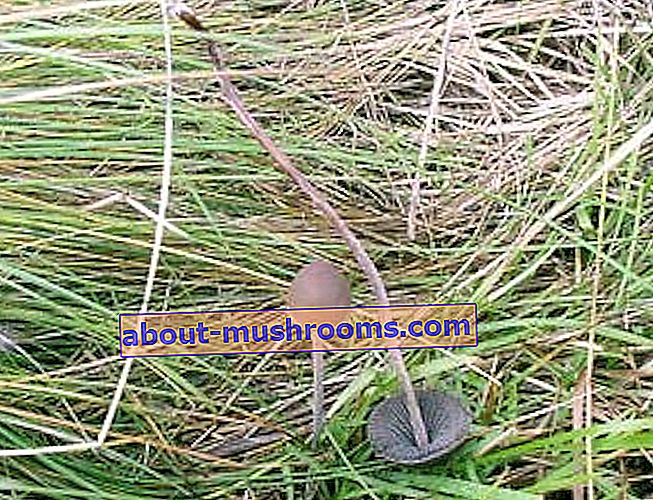Paneolus moth (Panaeolus papilionaceus)
Systematics:- Department: Basidiomycota (Basidiomycetes)
- Subdivision: Agaricomycotina (Agaricomycetes)
- Class: Agaricomycetes (Agaricomycetes)
- Subclass: Agaricomycetidae (Agaricomycetes)
- Order: Agaricales (Agaric or Lamellar)
- Family: Psathyrellaceae (Psatirellaceae)
- Genus: Panaeolus (Paneolus)
- Species: Panaeolus papilionaceus (Paneolus moth)
Synonyms:
- Agaricus papilionaceus
- Coprinus papilionaceus
 External description
External description
Hat: the cap of the mushroom is 1.5 to 4 cm in diameter. It has a blunt conical shape, which becomes bell-shaped during the maturation of the mushroom. At the edges, the cap is first slightly bent inward, then straightened. The surface of the cap is decorated with scaly fragments of a white bedspread. The fragments have a ragged triangular shape. With age, the fragments of the bedspread become almost invisible. The surface of the cap is smooth and dry; in rainy weather, the cap becomes slightly sticky. The surface is gray-brown or olive-brown in color. The tubercle may be yellowish brown or reddish brown. As the mushroom matures, the cap becomes lighter.
Blades: Wide, narrowly spaced pale gray blades with a mottled marble surface may be adhered to the peduncle. Sometimes the plates separate from it and become free. On the edges of the plate are lighter in color. They can turn black with age, since the spores from which they grow are black.
Leg: leg length from 6 to 12 cm. Thickness - from 2 to 4 cm. The stem of the mushroom is thin and fragile, hollow inside. Almost the same along the entire length, but sometimes it can expand at the bottom or top. The surface of the leg is striped in the upper part. In youth, the leg is covered with a whitish bloom. The leg is gray-brown. When pressed, the color becomes darker. The leg is covered in places with thin filmy white fibers, which are practically invisible. These fibers form fragments on the surface of the cap.
Spores: smooth, elliptical. Spore powder: black.
Flesh: The thin flesh is grayish or leathery brown in color. The pulp does not have a distinct odor. The flesh of the leg has a darker color.
Spread
Paneolus papilionaceus (Panaeolus papilionaceus) is found in pastures or on rotted grass. Grows in small groups in horse or cow dung. Sometimes it occurs singly, but rarely. The fruiting period is from spring to autumn.

Edibility
There is no information about the edibility of the mushroom, but it is not recommended to eat it, since it is possible that the mushroom contains a toxic substance - weakly concentrated psilocybin, which has moderate hallucinogenic properties. Some sources indicate this mushroom as poisonous.
Similarity
The genus Panaeolus is described differently in each source, and there are many different combinations. Be that as it may, Panaeolus moth is easy to distinguish by its size, the rest of the dung beetles are much smaller in stature.
Remarks
Paneolus moth (Panaeolus papilionaceus) is an amazingly regular and large mushroom. It grows in dense grass, but at the same time it has an even, straight shape. It is his correctness that distinguishes him from other similar species.

 External description
External description